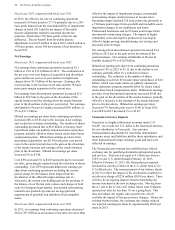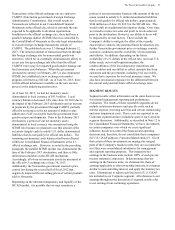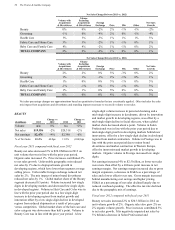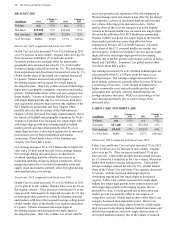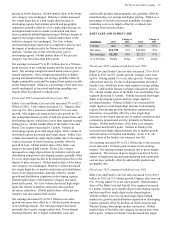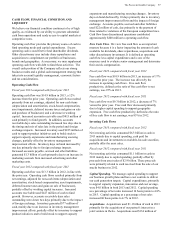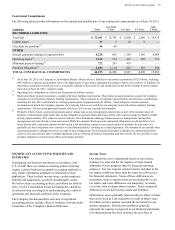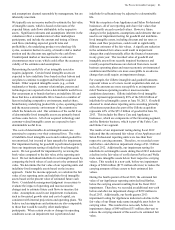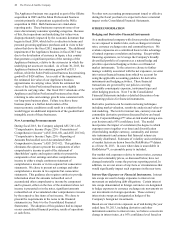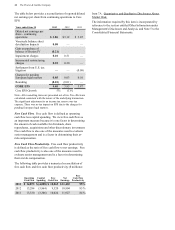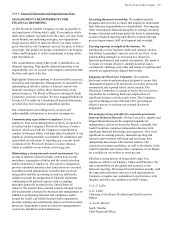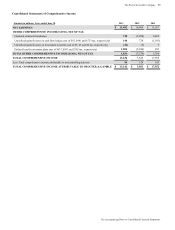Proctor and Gamble 2013 Annual Report Download - page 41
Download and view the complete annual report
Please find page 41 of the 2013 Proctor and Gamble annual report below. You can navigate through the pages in the report by either clicking on the pages listed below, or by using the keyword search tool below to find specific information within the annual report.
The Procter & Gamble Company 39
Contractual Commitments
The following table provides information on the amount and payable date of our contractual commitments as of June 30, 2013.
($ millions) Total
Less Than
1 Year 1-3 Years 3-5 Years
After
5 Years
RECORDED LIABILITIES
Total debt $ 31,441 $ 12,393 $ 6,004 $ 2,609 $ 10,435
Capital leases 31 518 8—
Uncertain tax positions(1) 46 46———
OTHER
Interest payments relating to long-term debt 8,220 865 1,382 1,169 4,804
Operating leases(2) 1,512 254 437 302 519
Minimum pension funding(3) 722 263 459 — —
Purchase obligations(4) 2,183 1,114 625 210 234
TOTAL CONTRACTUAL COMMITMENTS 44,155 14,940 8,925 4,298 15,992
(1) As of June 30, 2013, the Company's Consolidated Balance Sheet reflects a liability for uncertain tax positions of $2.0 billion, including
$447 million of interest and penalties. Due to the high degree of uncertainty regarding the timing of future cash outflows of liabilities for
uncertain tax positions beyond one year, a reasonable estimate of the period of cash settlement beyond twelve months from the balance
sheet date of June 30, 2013, cannot be made.
(2) Operating lease obligations are shown net of guaranteed sublease income.
(3) Represents future pension payments to comply with local funding requirements. These future pension payments assume the Company
continues to meet its future statutory funding requirements. These amounts do not include expected future discretionary contributions,
including the July 2013 contribution to a foreign pension plan of approximately $1 billion. Considering the current economic
environment in which the Company operates, the Company believes its cash flows are adequate to meet the future statutory funding
requirements. The projected payments beyond fiscal year 2016 are not currently determinable.
(4) Primarily reflects future contractual payments under various take-or-pay arrangements entered into as part of the normal course of
business. Commitments made under take-or-pay obligations represent future purchases in line with expected usage to obtain favorable
pricing. Approximately 20% relates to service contracts for information technology, human resources management and facilities
management activities that have been outsourced. While the amounts listed represent contractual obligations, we do not believe it is
likely that the full contractual amount would be paid if the underlying contracts were canceled prior to maturity. In such cases, we
generally are able to negotiate new contracts or cancellation penalties, resulting in a reduced payment. The amounts do not include other
contractual purchase obligations that are not take-or-pay arrangements. Such contractual purchase obligations are primarily purchase
orders at fair value that are part of normal operations and are reflected in historical operating cash flow trends. We do not believe such
purchase obligations will adversely affect our liquidity position.
SIGNIFICANT ACCOUNTING POLICIES AND
ESTIMATES
In preparing our financial statements in accordance with
U.S. GAAP, there are certain accounting policies that may
require a choice between acceptable accounting methods or
may require substantial judgment or estimation in their
application. These include income taxes, certain employee
benefits and acquisitions, goodwill and intangible assets.
We believe these accounting policies, and others set forth in
Note 1 to the Consolidated Financial Statements, should be
reviewed as they are integral to understanding the results of
operations and financial condition of the Company.
The Company has discussed the selection of significant
accounting policies and the effect of estimates with the Audit
Committee of the Company's Board of Directors.
Income Taxes
Our annual tax rate is determined based on our income,
statutory tax rates and the tax impacts of items treated
differently for tax purposes than for financial reporting
purposes. Tax law requires certain items be included in the
tax return at different times than the items are reflected in
the financial statements. Some of these differences are
permanent, such as expenses that are not deductible in our
tax return, and some differences are temporary, reversing
over time, such as depreciation expense. These temporary
differences create deferred tax assets and liabilities.
Deferred tax assets generally represent the tax effect of items
that can be used as a tax deduction or credit in future years
for which we have already recorded the tax benefit in our
income statement. Deferred tax liabilities generally
represent tax expense recognized in our financial statements
for which payment has been deferred, the tax effect of



